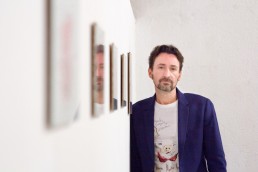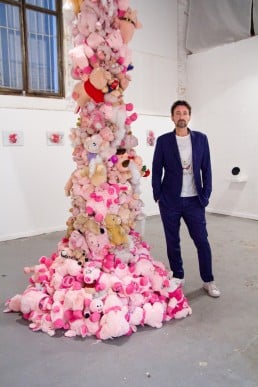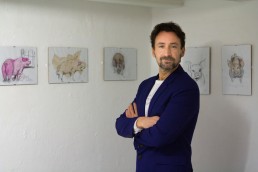“It’s really an art form to be a dealer. It’s a calling rather than a job”
Interview: Marc Trensig, Founder and Director of Hans & Fritz Contemporary
Providing artists a free space to experiment and showing what other galleries might not want or dare to, are top priorities to Marc Trensig. As a director of the gallery space Hans & Fritz Contemporary, located in Barcelona and Copenhagen, he dares to break with traditions and take chances by detracting the white cube format and opening up the gallery to the actual production process. His goal is to build an eye-opening, organic program that fosters knowledge and dialogue to a global audience, while constantly pushing the limits for his artists and himself. For Marc Trensig, being a dealer is not really a job. It is a calling.

Name:
HANS & FRITZ CONTEMPORARY
Locations:
BARCELONA, SPAIN
COPENHAGEN, DENMARK
Founded in year:
2015
Number of artists:
16
Upcoming exhibitions:
Solo shows by SATOSHI HASHIMOTO (JP), LILIBETH CUENCA RASMUSSEN (DK/ PH), MARC BADIA (ES), FREDERIK VAN SIMAEY (BE), JEANETTE EHLERS (DK/TT), MOMU & NO ES (ES/CH) …etc.
When did you first get interested in art, and how did it lead you into the business of being a gallerist?
I’ve been interested in art as long as I can remember. Although my art practice has always been there alongside my other interests, I felt very much engaged with the work of other artists, so it felt like a natural transition. It wasn’t until after establishing a relationship with my partner/dealer and having dug deeply into this highly complex and multifaceted occupation that I decided to open the gallery.
How would you describe the program and vision of your gallery?
Hans & Fritz Contemporary is a space created for experimentation, mediation, advancement, and promotion of its artists. We work mainly with internationally renowned artists and aim to create a platform for cultural exchange and collaboration as well as a dynamic space that resolutely works to infuse new interests and knowledge to our guests and clients. I have experimented a lot with artists, exhibition formats, spatial configurations, and time frames. Looking back, I would not change a thing. For me, building a program should not be premeditated or proscribed, but thoughtful, organic, and responsive to current times.
What sets your gallery apart?
There’s an old slogan from the Danish newspaper Ekstra Bladet, “Tør – hvor andre tier” (“Dare – Where Others Stay Silent”) …I think this could be used to describe Hans & Fritz Contemporary’s vision. We show what other galleries might not want to or don’t dare to for commercial reasons.
You represent a diverse group of artists. Are they somehow related in their artistic practices?
I am very open-minded. There isn’t a specific criterion, medium, or tendency to which I force myself to focus on. Instead, I try to focus on current artistic ideas and the emerging trends in the contemporary art scene.

More of your artists, among others Lilibeth Cuenca Rasmussen, Jeannette Ehlers, and Katja Bjørn, work with film as one of their primary mediums. How much does your background in the film industry influence your work as a gallerist?
One of the key differences between video art and theatrical cinema is that video art does not necessarily rely on many of the conventions that define theatrical cinema. While my background may come from the film industry, which might give me a larger insight into this medium, I believe my largest influence with regards to my work as a gallerist stems from my own artistic practice. One has to appreciate that at the beginning of the 80s, even the 90s, video was a medium that was more or less rejected in the artistic circuits by museums as much as by galleries – galleries above all, as it was hard to commercialize.
Although video is now one of the most common media among established and emerging artists alike, the vast majority of collectors don’t always understand the use of an ephemeral medium because the valuation of material artworks is still deeply rooted in Western culture. The importance of durability and of exclusively possessing an artwork prevents them from realizing that we are only temporary holders of art. Videos often frustrate the viewer’s sense of owning a unique work. Today, museums are increasingly incorporating moving image based productions in their collections, while new art institutions exclusively devoted to the research, exhibition, and conservation of film and video art are emerging. A significant number of film festivals and art fairs include or are devoted to video art, and it is not rare to find video art or video installation pieces at art fairs. Even entire collections are devoted to this medium.
Where and how do you find new artists to exhibit and what do you look for when considering a new artist for your gallery?
Artists come through various channels. Some are recommended by your own artists, others by curators, at art fairs, visiting studios. The most important part is finding the right artist for you. I believe the relationship between the galleries and the artist is a close one or can become a very close one. I don’t sign up any artist unless I’ve worked with them before, either through a show or in a different context before we decide. I believe my work with an artist is a long-term relationship and it’s very important that there’s a mutual feeling of trust. Many hours are put into the work every time I collaborate with an artist – so I find it very important that I feel passionate about what they do and feel the need to have a personal connection with them. It is not necessarily because the specific artist will make me a lot of money, but I must feel passionate about them and their work.
Who is the most recent artist to join your gallery and why did you choose him/her?
The most recent artists signing up for the gallery are a Belgian artist called FREDERIK VAN SIMAEY and a Swiss/Spanish female duo established in Rotterdam called MOMU & NO ES. Aiming for a diverse group of artists from different mediums and styles to represent the current artistic ideas and emerging trends, FREDERIK VAN SIMAEY together with SATOSHI HASHIMOTO (JP) are my newest venture into the conceptual. FREDERIK VAN SIMAEY is able to ‘re-contextualize’ simple materials, converting the act of deliberately letting things falter into an art where the profane form avoids every pitfall of gratuitous and glittering aestheticism. A well-dosed coating of ‘no nonsense’ takes control of his artistic activity, which manifests itself as a bountiful series of works that closely follows his own life. The recent work of MOMU & NO ES (Eva Noguera and Lucía Moreno) revolves around the construction of stories, habits, and routines stemming from their immediate surroundings. By questioning social roles and modifying the established rules, they propose other possible alternatives, using fiction and ingenuity to develop a series of storylines, events, and fables that draw on the post-internet era and on elements of popular culture.
Can you tell us about the process of curating your exhibitions and the collaboration with the artists?
First of all, I detract from the white cube format. I would basically call it a hybrid type of space – something in-between a Kunsthal, project space, production house, and a commercial gallery. Each exhibition is produced specifically for the space and I work closely with the artists for a long time ahead of the exhibition, making each show totally individual and interesting to the artist and the audience. The exhibition is just the front end of a long period of collaboration.

Your exhibitions are often site-specific, specially designed for your gallery. Why do you choose this approach and how does it influence the creative process of the artists?
I believe that part of my job is to give the artists a space to freely experiment and think outside the box – challenging the artist’s limits and forcing him/her out of their comfort zone – something very few galleries worldwide actually do. I like the freshness of this approach, and I even consider the process as important as the end result. By opening the gallery, on several occasions, during the actual production process and build-up of the show, I have invited the visitors to become part of this sensual experience normally closed off to the public in general.
Today, a lot of your business as a gallerist is conducted at art fairs or online. What is the value of having a physical space?
Most Millennials, which are the new target market, have a different way of engaging with art. They play, shop, get inspired, and advocate using Instagram and Pinterest, amongst other platforms, and there is no reason why this trend will not continue – young buyers will continue to purchase more efficiently online.
Although I believe the online market is growing bigger and art fairs are necessary – it’s fundamental to have a physical space as a gallery in the current system. The art business is much more about the artists, seeing the works physically, and establishing trust by knowing the gallerist and his/her personal vision. At the same time, almost every notable fair still requires that applicants maintain a permanent physical exhibition space somewhere in the world to be eligible for acceptance.
How did you end up in Barcelona, and how would you describe the current art scene in the city?
I was born in Barcelona from Danish parents. After having lived in various countries for many years, when considering where to start the gallery and staying aware of its complexities, I had no doubt that Barcelona would be the ideal place for me. I would best describe the art scene in Barcelona as emerging or a growing market. There is a growing interest in contemporary art in the city, but it is still not nearly as established as the market in cities such as London or New York. For that reason, our presence internationally is paramount to the growth of our gallery program. It’s a real privilege to be a major force in converting Barcelona into an important player on the global art scene.
Who is your main audience, primarily local or international collectors?
Since it’s conception HANS & FRITZ CONTEMPORARY has always had a focus on existing as part of the global art dialogue. I often describe my gallery as an art gallery in Spain rather than a Spanish art gallery. I work to achieve this by inviting international artists to exhibit in Barcelona as well as promote my artists abroad through art fairs and partnerships with other galleries across the globe. Basically, it’s a combination of both. We work internationally but do not forget the local.
What role do the art fairs play for you as a gallerist?
Although there is a necessity for art fairs in the current market, I don’t think we should put all our eggs in one basket. The expense and stress inherent to the non-stop art-fair calendar has taken a toll, especially on smaller galleries with less capital, less staff, and more of a penchant for riskier presentations. Many dealers are now looking beyond the traditional “gallery-plus-fairs” model—and they recapture the spirit that got them into the business in the first place.
Gallery shares, co-ops, and other fair alternatives are all at rage. Although there may be an upside to these challenges, I can’t imagine the fair structure not being in place for the next 10 years. Despite their appeal, these models are unlikely to be a wonder drug for struggling mid-tier galleries—nor are they likely to fully supplant the traditional art fair. Still, dealers hope to eventually participate in fewer fairs— instead of the grueling schedule that many maintain now—and more Coop-like events. It just feels more manageable for everyone: the gallery, the artist, and even the collector.
“I believe that part of my job is to give the artists a space to freely experiment and think outside the box – challenging the artist’s limits and forcing him/her out of their comfort zone – something very few galleries worldwide actually do.”
How does digitalization affect the dynamic of your business?
The digital will define the future of contemporary art. New media, digital video art, net art, digital sculpture, interactive multimedia, and the vast panorama of hybrid forms of art and technology constitute our present moment in culture.
Are there any websites you rely on for a view of the art world?
Artland of course, Artsy, Artnet, Artspace, Mousse magazine, Artnewspaper, newsletters…You basically rely on a combination of so many different channels.
What or who has influenced you as a gallerist?
There are many people that have influenced me and not only from the art world – Other creative industries too, like film, design, fashion and architecture. I would not be able to choose one particular person.
What are the most challenging and rewarding aspects of being a gallerist?
Every day is a challenge. A gallery isn’t a typical business – it’s a way of life. It’s really an art form to be a dealer. It’s a calling rather than a job.
This job isn’t always easy, and it’s extremely demanding in terms of the amount of time and energy invested. But every day, I’m grateful for the opportunity to work with artists, and to collaborate with such an incredible staff at the gallery.
Can you tell us a bit about your next upcoming show?
I am preparing a solo show with the Japanese artist SATOSHI HASHIMOTO, where he intends to involve the viewers and question their roles in the experience of art in the form of performances, actions and instructions, aimed at inducing the viewers’ own reactions. His sometimes unreasonable instructions and his actions that freely transcend any borders pose questions regarding our principles of existence.
What are your future plans for the gallery?
The most important is maintaining a high standard program of exhibitions, events, and performances in the gallery. Currently, I am working on the next international expansion phase, which, among other aspects, includes art fairs, co-ops, and other alternative models. Independently, I am working on setting up different short-term exhibitions outside the conventional gallery format organized in spaces that are similar to the gallery in concept, image, style and/or attitude. Currently, I am working on one in Switzerland, Belgium, The Netherlands, and of course Copenhagen… Additionally, I recently opened a permanent space in Copenhagen, which will basically assist the northern European markets and Scandinavia.
RECOMMENDATIONS
Top three artists to watch:
1. Tabita Rezaire (GF/DK)
2. Tianzhuo Chen (CH)
3. Rachel Maclean (GB)
Top three pieces of advice for new collectors
1. I think working with somebody who has integrity, honesty, and a good reputation—which will lead to a trusting relationship—is critical for collectors, especially in the beginning. In addition, I think that it is critical to work with someone who has a similar eye for art.
2. Focus on one sort of collecting. I think that many people start collecting, and they buy a little bit here and a little bit there. I think it’s more sensible for people to find a dealer that has a very strong program of interest to the collector. Then, build a relationship with that dealer. This way they will be offered better work or first choice of work.
3. It’s very tempting to look around and see what other people are doing and want to duplicate a model that exists or a model that is very successful already. But I say, do it your own way. The authenticity of doing it in your own original way is, in the end, what will distinguish you. You don’t have to make a commitment for life. It’s supposed to enliven your life. Collecting is something for the soul.
Top three art destinations
1. LOS ANGELES
2. WARSAW
3. COPENHAGEN / BARCELONA
HANS & FRITZ CONTEMPORARY BARCELONA
San Gil 17
08001 Barcelona
+34 934637545
HANS & FRITZ CONTEMPORARY COPENHAGEN
Griffenfeldtsgade 7A, Baghuset
2200 København N
+45 20970082
OPENING HOURS
Monday – Friday:
12 – 18 hrs or by appointment
WEBSITE
www.hans-fritz.com
Get your free copy of Artland Magazine
More than 60 pages interviews with insightful collectors.
